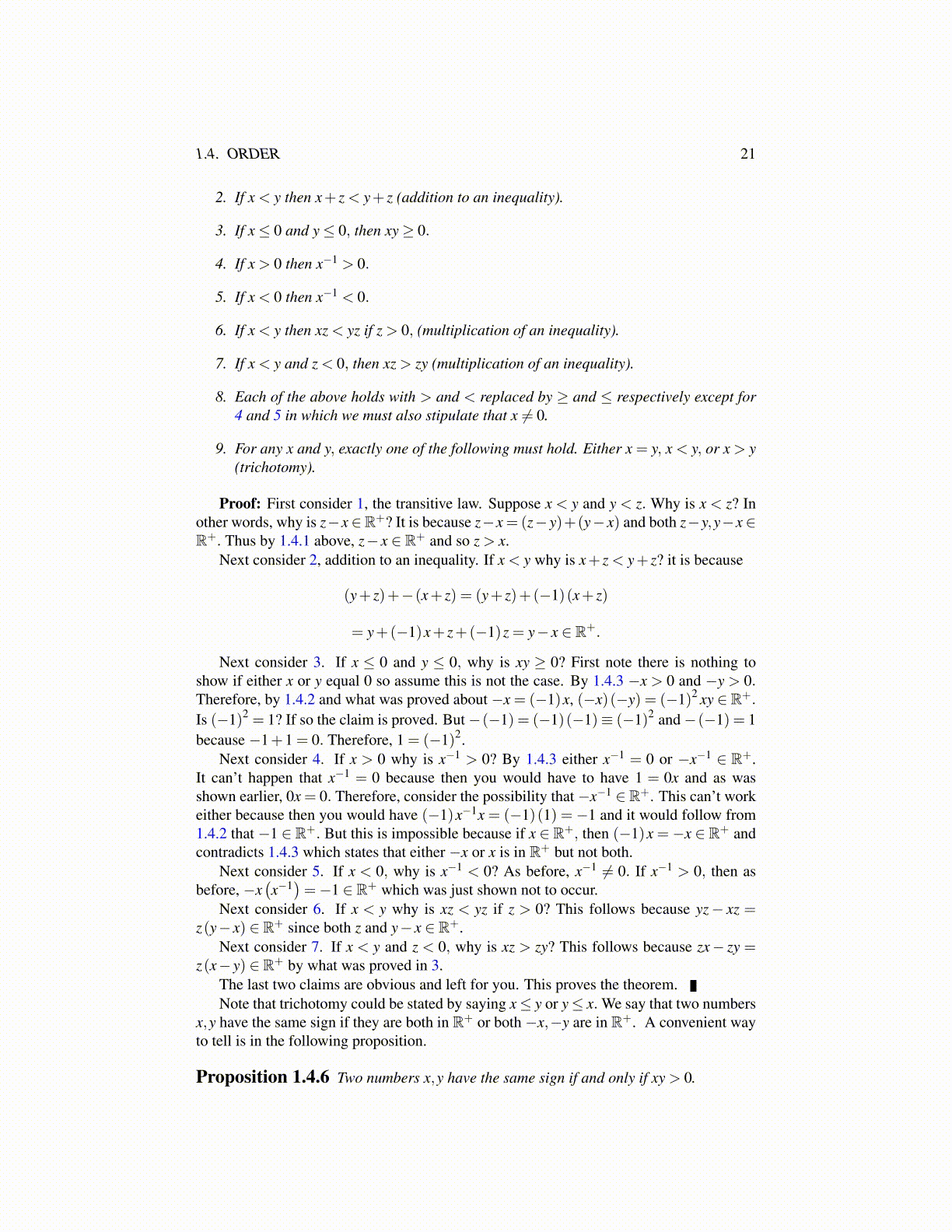
1.4. ORDER 21
2. If x < y then x+ z < y+ z (addition to an inequality).
3. If x ≤ 0 and y ≤ 0, then xy ≥ 0.
4. If x > 0 then x−1 > 0.
5. If x < 0 then x−1 < 0.
6. If x < y then xz < yz if z > 0, (multiplication of an inequality).
7. If x < y and z < 0, then xz > zy (multiplication of an inequality).
8. Each of the above holds with > and < replaced by ≥ and ≤ respectively except for4 and 5 in which we must also stipulate that x ̸= 0.
9. For any x and y, exactly one of the following must hold. Either x = y, x < y, or x > y(trichotomy).
Proof: First consider 1, the transitive law. Suppose x < y and y < z. Why is x < z? Inother words, why is z−x ∈R+? It is because z−x = (z− y)+(y− x) and both z−y,y−x ∈R+. Thus by 1.4.1 above, z− x ∈ R+ and so z > x.
Next consider 2, addition to an inequality. If x < y why is x+ z < y+ z? it is because
(y+ z)+−(x+ z) = (y+ z)+(−1)(x+ z)
= y+(−1)x+ z+(−1)z = y− x ∈ R+.
Next consider 3. If x ≤ 0 and y ≤ 0, why is xy ≥ 0? First note there is nothing toshow if either x or y equal 0 so assume this is not the case. By 1.4.3 −x > 0 and −y > 0.Therefore, by 1.4.2 and what was proved about −x = (−1)x, (−x)(−y) = (−1)2 xy ∈ R+.
Is (−1)2 = 1? If so the claim is proved. But −(−1) = (−1)(−1)≡ (−1)2 and −(−1) = 1because −1+1 = 0. Therefore, 1 = (−1)2.
Next consider 4. If x > 0 why is x−1 > 0? By 1.4.3 either x−1 = 0 or −x−1 ∈ R+.It can’t happen that x−1 = 0 because then you would have to have 1 = 0x and as wasshown earlier, 0x = 0. Therefore, consider the possibility that −x−1 ∈R+. This can’t workeither because then you would have (−1)x−1x = (−1)(1) =−1 and it would follow from1.4.2 that −1 ∈ R+. But this is impossible because if x ∈ R+, then (−1)x =−x ∈ R+ andcontradicts 1.4.3 which states that either −x or x is in R+ but not both.
Next consider 5. If x < 0, why is x−1 < 0? As before, x−1 ̸= 0. If x−1 > 0, then asbefore, −x
(x−1)=−1 ∈ R+ which was just shown not to occur.
Next consider 6. If x < y why is xz < yz if z > 0? This follows because yz− xz =z(y− x) ∈ R+ since both z and y− x ∈ R+.
Next consider 7. If x < y and z < 0, why is xz > zy? This follows because zx− zy =z(x− y) ∈ R+ by what was proved in 3.
The last two claims are obvious and left for you. This proves the theorem.Note that trichotomy could be stated by saying x ≤ y or y ≤ x. We say that two numbers
x,y have the same sign if they are both in R+ or both −x,−y are in R+. A convenient wayto tell is in the following proposition.
Proposition 1.4.6 Two numbers x,y have the same sign if and only if xy > 0.